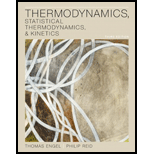
Thermodynamics, Statistical Thermodynamics, & Kinetics
3rd Edition
ISBN: 9780321824004
Author: ENGEL, Thomas/ Reid
Publisher: Pearson College Div
expand_more
expand_more
format_list_bulleted
Question
Chapter 3, Problem 3.36NP
Interpretation Introduction
Interpretation:
For an ideal gas, the following relation needs to be proved.
Also, CP and CV are independent of pressure and volume needs to be proved.
Concept Introduction :
In
Expert Solution & Answer
Want to see the full answer?
Check out a sample textbook solution
Students have asked these similar questions
Draw the product formed when the following pair of compounds is treated with NaOEt in ethanol.
+
i
CN
I need help with the following
Explain the reasons for the color changes that occur when the gel and the solution examined dry.
Chapter 3 Solutions
Thermodynamics, Statistical Thermodynamics, & Kinetics
Ch. 3 - Prob. 3.1CPCh. 3 - Prob. 3.2CPCh. 3 - Prob. 3.3CPCh. 3 - Prob. 3.4CPCh. 3 - Why can qv be equated with a state function if q...Ch. 3 - Prob. 3.6CPCh. 3 - Prob. 3.7CPCh. 3 - Prob. 3.8CPCh. 3 - Prob. 3.9CPCh. 3 - Why is qv=U only for a constant volume process? Is...
Ch. 3 - Prob. 3.11CPCh. 3 - Why are q and w not state functions?Ch. 3 - Prob. 3.13CPCh. 3 - What is the relationship between a state function...Ch. 3 - Prob. 3.15CPCh. 3 - Is the following statement always, never, or...Ch. 3 - Is the following statement always, never, or...Ch. 3 - Prob. 3.18CPCh. 3 - Prob. 3.19CPCh. 3 - Is the expression UV=T2T1CVdT=nT1T2CV,mdT only...Ch. 3 - Prob. 3.1NPCh. 3 - Prob. 3.2NPCh. 3 - Prob. 3.3NPCh. 3 - Prob. 3.4NPCh. 3 - Prob. 3.5NPCh. 3 - Prob. 3.6NPCh. 3 - Integrate the expression =1/VV/TP assuming that ...Ch. 3 - Prob. 3.8NPCh. 3 - Prob. 3.9NPCh. 3 - Prob. 3.10NPCh. 3 - Prob. 3.11NPCh. 3 - Calculate w, q, H, and U for the process in which...Ch. 3 - Prob. 3.13NPCh. 3 - Prob. 3.14NPCh. 3 - Prob. 3.15NPCh. 3 - Prob. 3.16NPCh. 3 - Prob. 3.17NPCh. 3 - Prob. 3.18NPCh. 3 - Prob. 3.19NPCh. 3 - Prob. 3.20NPCh. 3 - Prob. 3.21NPCh. 3 - Prob. 3.22NPCh. 3 - Derive the following relation, UVmT=3a2TVmVm+b for...Ch. 3 - Prob. 3.24NPCh. 3 - Prob. 3.25NPCh. 3 - Prob. 3.26NPCh. 3 - Prob. 3.27NPCh. 3 - Prob. 3.28NPCh. 3 - Prob. 3.29NPCh. 3 - Prob. 3.30NPCh. 3 - Prob. 3.31NPCh. 3 - Prob. 3.32NPCh. 3 - Prob. 3.33NPCh. 3 - Prob. 3.34NPCh. 3 - Derive the equation H/TV=CV+V/k from basic...Ch. 3 - Prob. 3.36NPCh. 3 - Prob. 3.37NPCh. 3 - Show that CVVT=T2PT2VCh. 3 - Prob. 3.39NP
Knowledge Booster
Similar questions
- For Raman spectroscopy/imaging, which statement is not true regarding its disadvantages? a) Limited spatial resolution. b) Short integration time. c) A one-dimensional technique. d) Weak signal, only 1 in 108 incident photons is Raman scattered. e) Fluorescence interference.arrow_forwardUsing a cell of known pathlength b = 1.25115 x 10-3 cm, a water absorption spectrum was measured. The band at 1645 cm-1, assigned to the O-H bending, showed an absorbance, A, of 1.40. a) Assuming that water density is 1.00 g/mL, calculate the water molar concentration c (hint: M= mole/L) b) Calculate the molar absorptivity, a, of the 1645 cm-1 band c) The transmitted light, I, can be written as I= Ioexp(-xb), where x is the absorption coefficient (sometimes designated as alpha), Io is the input light, and b is the cell pathlength. Prove that x= (ln10)*x*c. (Please provide a full derivation of the equation for x from the equation for I). d) Calculate x for the 1645 cm-1 bandarrow_forwardI need help with the follloaingarrow_forward
- For a CARS experiment on a Raman band 918 cm-1, if omega1= 1280 nm, calculate the omega2 in wavelength (nm) and the CARS output in wavelength (nm).arrow_forwardI need help with the following questionarrow_forwardFor CARS, which statement is not true regarding its advantages? a) Contrast signal based on vibrational characteristics, no need for fluorescent tagging. b) Stronger signals than spontaneous Raman. c) Suffers from fluorescence interference, because CARS signal is at high frequency. d) Faster, more efficient imaging for real-time analysis. e) Higher resolution than spontaneous Raman microscopy.arrow_forward
- Draw the major product of the Claisen condensation reaction between two molecules of this ester. Ignore inorganic byproducts. Incorrect, 5 attempts remaining 1. NaOCH3/CH3OH 2. Acidic workup Select to Draw O Incorrect, 5 attempts remaining The total number of carbons in the parent chain is incorrect. Review the reaction conditions including starting materials and/or intermediate structures and recount the number of carbon atoms in the parent chain of your structure. OKarrow_forwardUsing a cell of known pathlength b = 1.25115 x 10-3 cm, a water absorption spectrum was measured. The band at 1645 cm-1, assigned to the O-H bending, showed an absorbance, A, of 1.40. a) Assuming that water density is 1.00 g/mL, calculate the water molar concentration c (hint: M= mole/L) b) Calculate the molar absorptivity, a, of the 1645 cm-1 band c) The transmitted light, I, can be written as I= Ioexp(-xb), where x is the absorption coefficient (sometimes designated as alpha), Io is the input light, and b is the cell pathlength. Prove that x= (ln10)*x*c d) Calculate x for the 1645 cm-1 bandarrow_forwardConvert 1.38 eV into wavelength (nm) and wavenumber (cm-1) (c = 2.998 x 108 m/s; h = 6.626 x 10-34 J*s).arrow_forward
arrow_back_ios
SEE MORE QUESTIONS
arrow_forward_ios
Recommended textbooks for you
 Chemistry: The Molecular ScienceChemistryISBN:9781285199047Author:John W. Moore, Conrad L. StanitskiPublisher:Cengage Learning
Chemistry: The Molecular ScienceChemistryISBN:9781285199047Author:John W. Moore, Conrad L. StanitskiPublisher:Cengage Learning Chemistry: Principles and ReactionsChemistryISBN:9781305079373Author:William L. Masterton, Cecile N. HurleyPublisher:Cengage Learning
Chemistry: Principles and ReactionsChemistryISBN:9781305079373Author:William L. Masterton, Cecile N. HurleyPublisher:Cengage Learning Physical ChemistryChemistryISBN:9781133958437Author:Ball, David W. (david Warren), BAER, TomasPublisher:Wadsworth Cengage Learning,
Physical ChemistryChemistryISBN:9781133958437Author:Ball, David W. (david Warren), BAER, TomasPublisher:Wadsworth Cengage Learning,

Chemistry: The Molecular Science
Chemistry
ISBN:9781285199047
Author:John W. Moore, Conrad L. Stanitski
Publisher:Cengage Learning

Chemistry: Principles and Reactions
Chemistry
ISBN:9781305079373
Author:William L. Masterton, Cecile N. Hurley
Publisher:Cengage Learning

Physical Chemistry
Chemistry
ISBN:9781133958437
Author:Ball, David W. (david Warren), BAER, Tomas
Publisher:Wadsworth Cengage Learning,